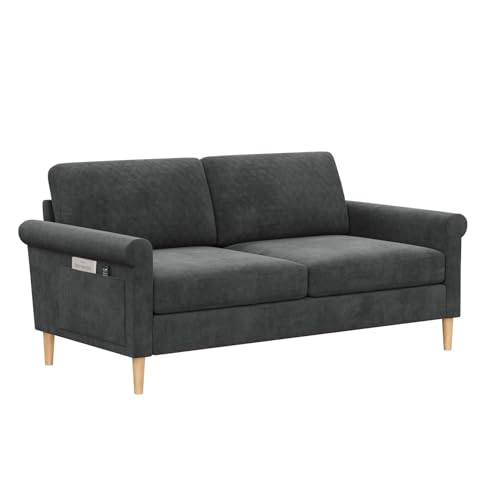Guide To 2 Seater Leather And Fabric Sofa: The Intermediate Guide For …
페이지 정보
작성자 Mei Norrie 댓글 0건 조회 2회 작성일 24-11-06 11:32본문
 Choosing Between a 2 Seater Leather and Fabric Sofa
Choosing Between a 2 Seater Leather and Fabric SofaIt isn't easy to decide between 2 seater fabric tub sofa and leather when you're looking for a new sofa. This is particularly relevant if you're new to experience with furniture.
If you have children or live in a small two seater fabric sofa apartment the leather option might be the best choice for you. It is easy to maintain and looks gorgeous in most homes.
Comfort
A sofa is the main focal feature of many people's living areas and is a major purchase. You want one that is comfortable to sit on for a long time, looks great, fits with your decor and will last for a long time. It isn't easy to decide between leather and fabric, but you should consider your budget, lifestyle, and your priorities prior to making a choice.
Leather is a high-end material that has a luxurious feel and is elegant in a home. It is durable and stain-resistant. It is also resistant to pets and children, and can last for a long time if properly cared for. However, it can be more expensive initially and will require regular conditioning to avoid peeling or cracking.
Fabric sofas are available in a wide range of styles, colours and fabrics. They are often cheaper than leather sofas. They are also softer and more inviting and can feel "broken in" from the start. They could be more vulnerable to dust mites and pet hairs, and require frequent cleaning. There are now hypoallergenic fabrics as well as new technologies that are available.
Fabric 2 seater sofas sale sofas can last for up to 15 years if maintained properly. Regular vacuuming and deep cleaning aid in keeping the fabric clean and free of odours and spills. They can also be stretched and flatten over time, just as leather. Additionally, many couches made of fabric have been treated with chemical to make them stain-resistant as well as flame-resistant. They can release volatile organic chemicals that could cause allergies and affect indoor air quality.
Durability
We typically choose sofas with fabrics that are robust, particularly if we have children or pets. You don't have to spend a lot of money upfront in case you'll regret it after the very first smudge or claw. You don't want to buy something cheap that won't hold up to daily use.
Leather, meanwhile, is extremely resilient and has a remarkable tear strength. It can last up to four times longer than fabric and is naturally resistant to cracking, fading and flaking over time. It can be treated to replenish its natural oils, and to make it appear new.
Fabrics are less expensive and come in a variety of colors, patterns, and textures that can be adjusted to any interior design scheme. Fabrics are less difficult to clean and are able to withstand some wear and tear. However, they may fade over time and are more prone to moisture.
Microfiber is durable and comes in a range of colors. However, it may not be as strong as genuine leather. It might also not be able to withstand scratches. However, it's still an excellent choice for families because of its resistance to stains and spills and is easy to clean typically with a damp cloth.
Suede, on the other hand is a challenge to maintain clean and can be even more difficult to repair than leather. It's shape can change and feel rough if it is not maintained regularly. It's also a thin material, and therefore may not be as strong as sheepskin leather or cowhide.
Allergens
The material your sofa is made from can have a significant impact on your allergies, which is why it's crucial to know the various options that are available. Fabrics are known to hold allergens like dust mites and pet dander, which can trigger symptoms like hay fever, asthma, rhinitis and eczema. This is because they provide the perfect environment in which they can thrive.
Leather is, however isn't susceptible to accumulating these allergens, and can provide consistent comfort regardless of the season. However, it could be a trigger for dermatitis, particularly in those who suffer from contact dermatitis and are sensitive to the chemicals used in the tanning process. To minimize the risk of skin reactions, it's essential to use products made from vegetable oils and keep a consistent skincare routine.
Both leather and fabric sofas are durable, but the material you choose will have a significant effect on how well your sofa can stand up to wear. A high-quality 2 seater fabric tub sofa will hold up to daily use without fading or sagging and will withstand spills and body oils easily. Many modern fabric couches come with stain-resistant treatment to make cleaning easier.
It's not possible to completely prevent an allergic reaction to the leather of your sofa, but you can help to avoid allergens by keeping a lint-roller nearby and regularly vacuum your living space. This will help in reducing the amount of pet hair, dirt and dust mites that accumulate on your sofa. If you still suffer from allergies, consider replacing your sofa with a hypoallergenic one. For instance, a couch made of synthetic or vinyl will not keep dust or pet dander out of the mites. It will also help you breathe better.
Scratches
When you are buying a leather sofa, it is important to think about the amount of wear and tear you can anticipate from it. The finish, colour and the quality of the leather are all crucial aspects in how long a couch will last. Also, you must make sure that it is durable enough to withstand spillages and other accidents. This can be achieved by selecting a couch that has a hardwood frame and high-density foam cushions.
Leather can be damaged due to various reasons, including stretching it, marking territory or the reliving of tension. Scratches can vary in severity, from small surface scratches to large punctures and cuts. Minor scratches can be repaired by using a leather conditioner. This will restore the balance between moisture and oil in the leather and stop it from drying out or cracking. Deep scratches and cut may require a different treatment, depending on the amount of damage.
It is recommended for cat owners to trim their cat's nails on a regular basis. This will stop them from scratching the couch. You can also retrain your cat's scratching behavior by offering alternative scratching surfaces, like cardboard or sisal rope. You can also use a pet-safe furniture polish that you can apply with the help of a soft, clean cloth.
In addition to cleaning your leather sofa regularly, it's a good idea to keep it from direct sunlight and heat sources which can dry out the leather. This can cause cracks in the leather. Repairing this can be difficult and requires an overhaul. It is also a good idea to use a conditioner for leather to keep the leather soft.
Smell
A leather sofa is likely to have a different smell than fabric. It's because it's more porous and can absorb unwanted odors, such as smoke, body odor, or food easily. The good news is that the smells typically disappear over time particularly when you use a non-toxic cleaning product that is fragrance-free.
However, if the smell is strong, it could indicate that there's something wrong with the foam. This is usually caused by chemical off-gassing resulting from petroleum-based polyurethane. If this is a concern you should seek out couches manufactured with CertiPUR US certified natural latex.
Another way to tell if it's faux leather is to feel for texture or bumps on the back of a sofa. This indicates that the leather is not authentic top grain. You can also perform a visual check by tilting the sofa to one side and looking for any exposed upholstery backing. If you can smell it, then it's probably a synthetic material, such as polyurethane or polyester. These types of materials will have a different scent than leather.
 While a leather couch is more susceptible to picking up odors, the best way to prevent this is by regularly cleaning your sofa. This will help keep it looking its best and fresh, as well as preventing it from becoming stiff or cracking over time. Start by vacuuming, dusting and wiping the couch with baking soda (a natural method to get rid of odors). It is recommended to do this at least once every two weeks or more to rid your sofa of any dirt and dust accumulation. Apply leather conditioner to maintain the appearance and color of your sofa.
While a leather couch is more susceptible to picking up odors, the best way to prevent this is by regularly cleaning your sofa. This will help keep it looking its best and fresh, as well as preventing it from becoming stiff or cracking over time. Start by vacuuming, dusting and wiping the couch with baking soda (a natural method to get rid of odors). It is recommended to do this at least once every two weeks or more to rid your sofa of any dirt and dust accumulation. Apply leather conditioner to maintain the appearance and color of your sofa.- 이전글신뢰할 수 있는 카지노사이트 TOP 6: 안전한 온라인 베팅을 위한 선택 가이드 24.11.06
- 다음글해외구매대행사업 쇼핑몰 프로그램으로 도전했어요 24.11.06
댓글목록
등록된 댓글이 없습니다.


